Wie Sie den grauen Alltag in stylischem Ambiente erleben können, zeigt diese Badgestaltung. Hier wirken Wand und Boden in eleganter Beton-Spachteltechnik.
Von grauem Alltag ist oft die Rede – und gemeinhin bedeutet das eher Langeweile, Routine, Lustlosigkeit, Stress und Hektik. Dass Grau auch ganz andere Akzente im Alltagsleben setzen kann, beweist diese Bad-Gestaltung. Von grauem Alltag keine Spur. Hier präsentiert sich Grau vielmehr als effektvoller Farbton, mit lebendiger Struktur, in spannender Auftragstechnik und als beruhigende Flächeninszenierung. Mut zu Grau? Nein, Mut bedarf es keinen man muss nur die Idee und den Willen dazu haben.
Unsere frischgebackenen Hausbesitzer hatten die Idee – und verfolgten sie auch konsequent. Ihr Bad sollte mit Grau Schwung in den Tagesstart bringen. Und abends war eine sanfte Ausklangsstimmung gewünscht. Kein kaltes Weiß und keine grellen Töne, alles eher verhalten und doch wirkungsvoll. Und dass das mit Grau gelingt, zeigen die Bilder eindrucksvoll. Dazu ein paar Farbtupfer über Textilien und Accessoires, einen natürlichen Touch dank Holz, und ehrliche Materialien wie roher Stahl für die Tischkkufen und Beton für die Wandleuchten und Seifenschalen.
Stichwort Beton: Prägend für das Badambiente sind die großflächig verspachtelten Boden- und Wandbereiche in Betonoptik. Besser gesagt: Nicht nur der Boden im Hauptraum ist in diesem Look, auch die integrierten Nebenräume – Dusche und WC sind durchweg so gestaltet. Und dann eben auch die trennende Waschbeckenwand – als Blickfang im sonst zurückhaltend weiß gehaltenen Dachbad.
Boden und Wand optisch also aus einem Guss. Aus einem Guss bedeutet aber auch: Fugenfrei, ansatzfrei, rasterfrei. Das wiederum beruhigt das Auge und optimiert den Pflegeaufwand – besonders im Nassbereich. Denn durchweg homogen und glatt bieten so geartete Beschichtungen leicht zu reinigende Oberflächen. Selbst Kalk lässt sich mit üblichen Haushaltsreinigern leicht entfernen.
Dusch-Separee im All-inklusive-Look
Die Dusche ist ein Teilbereich des im Prinzip offenen Grundrisses, fensterseitig ver- steckt hinter der Waschtischwand. Dieser Bereich ist mit Ausnahme der Decke rundum ausgespachtelt, auch der Duschboden und selbst die praktische Wandnische. Nässe kann dem Material nichts anhaben, da die Flächen zum Schluss komplett versiegelt werden.
Und wenn zuvor sämtliche Rohwände – hier handelt es sich übrigens um ein Fertighaus mit Gipskarton-Innenwänden – lückenlos abgedichtet worden sind, kann auch hier keine Feuchtigkeit eindringen. Besonders wichtig in einem Bad: Rutschfest ist die Spachtelung auch.
Stichwort Spachtelung: Kommen wir noch zum gewählten Material und zu dessen Verarbeitung. Es handelt sich um ein Material, das als Pulver in Eimern geliefert wird und vor Ort mit Wasser zu einer pastösen Masse angerührt wird. Basis ist ein feingemahlener Zement aus Griechenland. Mit einem entsprechenden Flüssigpigment lassen sich hierbei schon Farbgebung und -intensität individuell einstellen. Das heißt für die Alltagstauglichkeit: Das Material ist durchgefärbt und bildet keine Blitzer bei Verletzung der Oberfläche (Kratzer, Anstöße etc.). Das Besondere jedoch ist die Oberflächenwirkung.
Spannende Optik: Ein Mix aus Glanz und Struktur
Wer denkt, Grau ist Langweilig und eintönig, der irrt: Grau zeigt sich hier in allen Schattierungen, mal etwas wolkig, mal leicht changierend, mal mit mehr Glanz, mal leicht aufgeraut, mal topfeben und glatt, mal dreidimensional und haptisch erlebbar. Keine Stelle gleicht der anderen und keine Wand der anderen. Der manuelle Auftrag ist erforderlich und gewollt – und damit eigentlich Programm.
Kleine vermeintliche Unstimmigkeiten sind nicht Fehler, sondern erwünschte Effekte. Es kommt wie es kommt, und doch steckt ein Grundprinzip dahinter: Schichtweises Auftragen und abschließendes Verpressen. Hier kommt dann die Kunst des Verarbeiters zu Geltung. Generell gilt: Zwei Auftragsschichten sind mindestens erforderlich und auch der richtige Zeitpunkt für den zweiten ist wichtig – etwa nach dreißig Minuten.
Und diese Schicht wird dann verpresst, das heißt mit der Traufel stark abgerieben beziehungsweise mit ständigem Richtungswechsel unter Druck und spezieller Schräghaltung des Werkzeugs (etwa 30 Grad) abgezogen. Hierbei ergeben sich dann die verschiedenen Oberflächeneffekte wie Glanz, Aufrauungen oder Ausrisse. Auch die Schattierungen sind Ergebnis der individuellen Oberflächenbehandlung, wobei bei großen Flächen lieber zwei Personen Hand in Hand arbeiten sollten. Das Material darf ja auch nicht zu früh trocken sein, um noch überarbeitet werden zu können.
Zum Schluss – nach ausreichender Austrockung (mindestens ein Tag) – werden alle Flächen versiegelt. Dazu dient eine Grundierung, die per Rolle aufgetragen wird. Damit werden die Spachtelflächen wasserfest und dauerhaft geschützt – sowohl am Boden als auch an den Wänden. Insgesamt ist diese Art der Flächengestaltung eine sehr handwerkliche. Das Ambiente ist nicht zu vergleichen mit sonstigen Putz- oder Fliesenwänden. Individuell, modern und absolut stylisch.
Schritt für Schritt Anleitung
Schritt 1 – Spachtelmasse einfärben
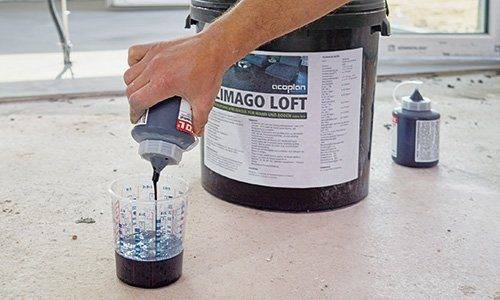
Schritt 2 – Pigment mit Wasser vermischen

Schritt 3 – Grundspachtel hinzugeben

Schritt 4 – Mischen wiederholen

Schritt 5 – Material auf Gipskartonflächen aufziehen
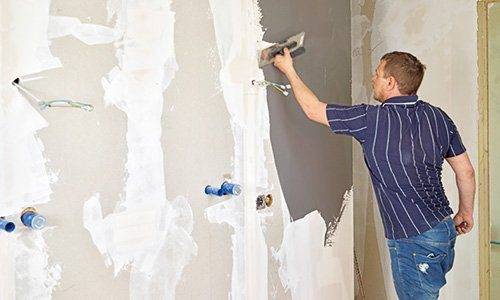
Schritt 6 -Material vollständig aufziehen
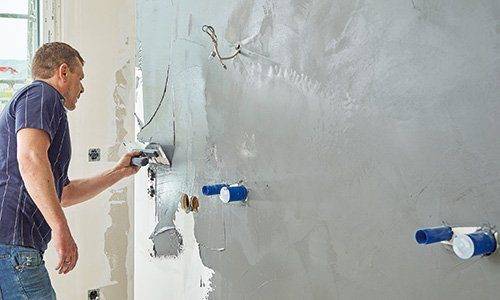
Schritt 7 – Zweiter Auftrag
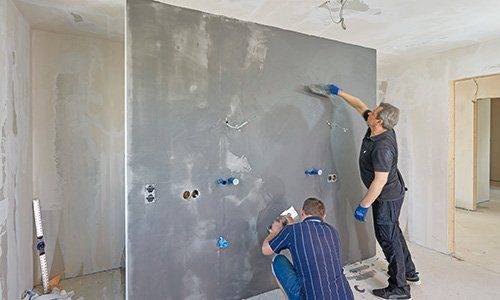
Schritt 8 – Verpressen
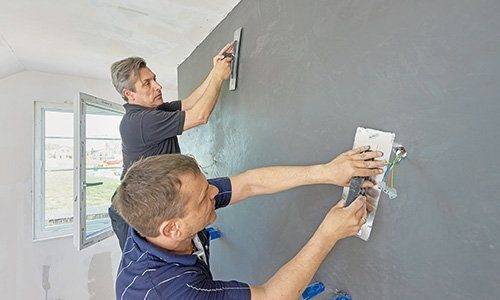
Schritt 9 – Boden vorbereiten
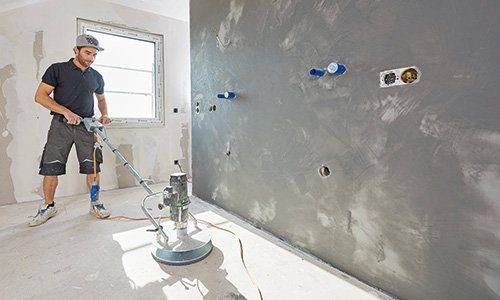
Schritt 10 – Grundierung beginnen

Schritt 11 – Boden gleichmäßig abrollen
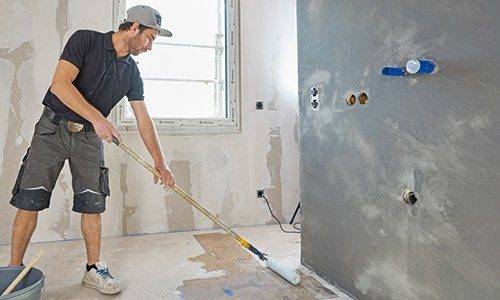
Schritt 12 – Bodenfläche spachteln
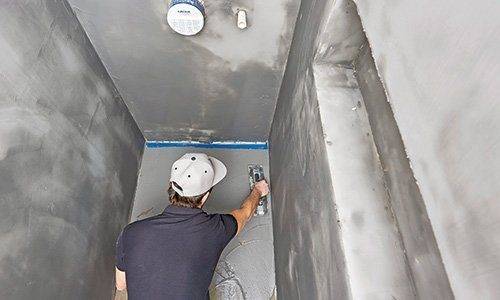
Schritt 13 – Badboden durchspachteln
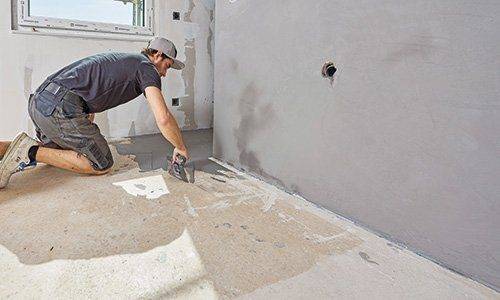
Schritt 14 – Zweiter Auftrag
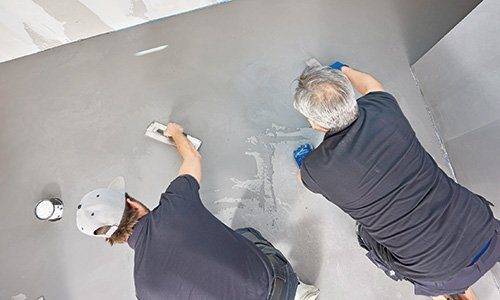
Schritt 15 – Trocknen
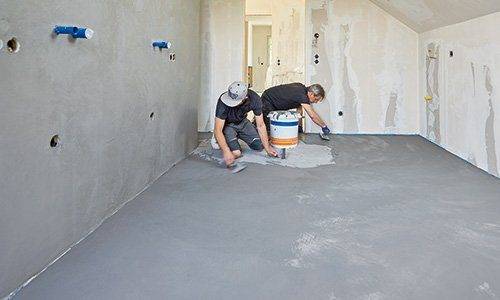
Schritt 16 – Imprägnierung
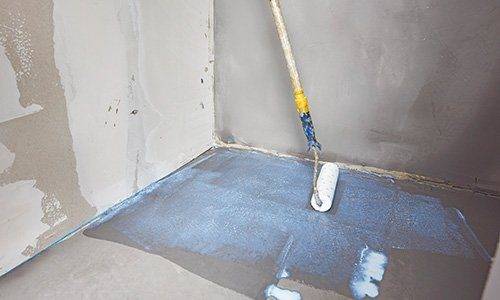
Schritt 17 – Boden imprägnieren
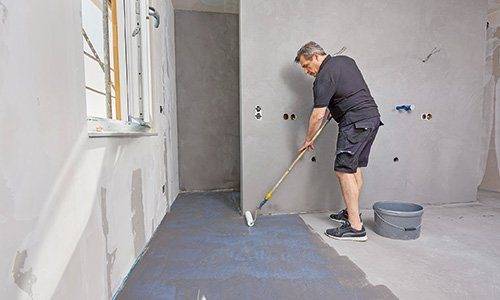
Schritt 18 – Wand imprägnieren
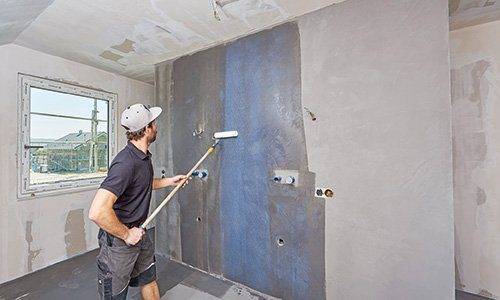
Weitere Informationen
Beton-Spachtelung, Bezeichnung Belimago Loft angeboten von www.acoplan.de.
Flexible, mineralische 1 K-Dichtschlämme Aquamat Monoelastic bietet www.isomat.at.
Essence Einhand-Wannenbatterie zur Bodenmontage, Essence 2-Loch-Wand-Waschtischbatterie, Edelstahl Supersteel sowie Grohtherm SmartControl Thermostat mit 2 Absperrventilen, Handbrause und Deckenkopfbrause von www.grohe.de.
PDF-Download: Bad in Beton-Optik
